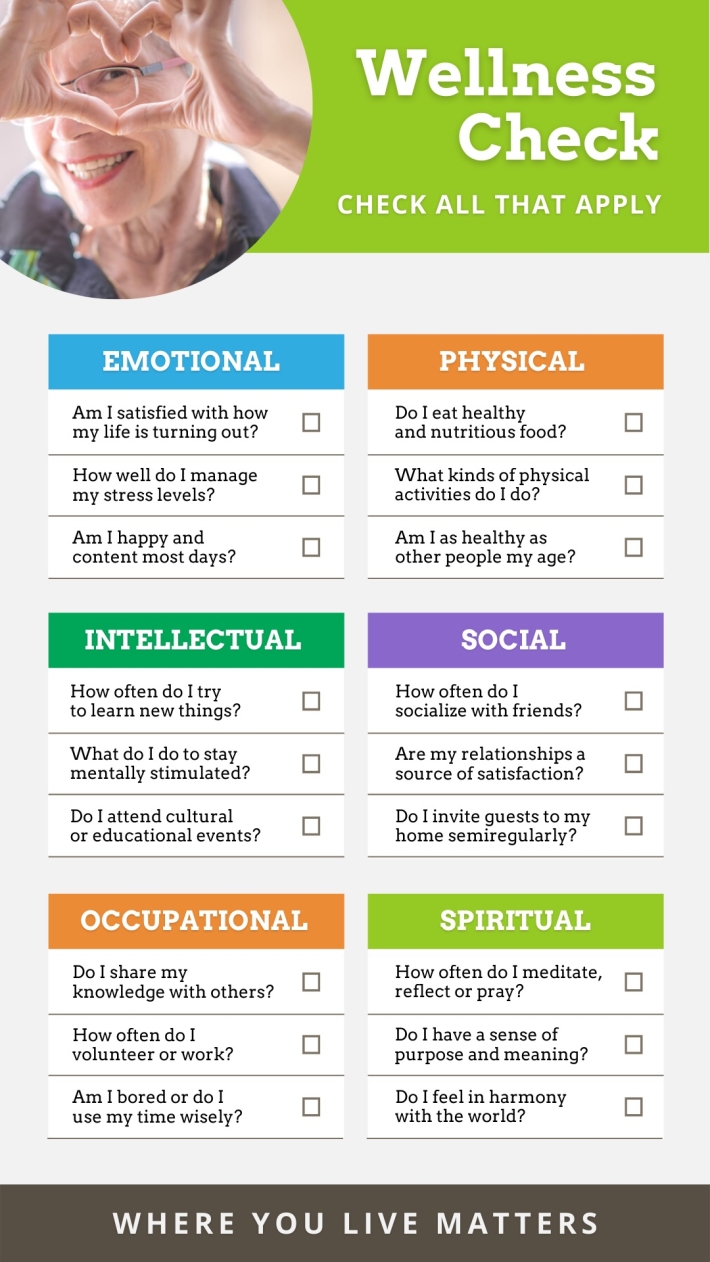The Dimensions of Wellness
Lifestyle matters when it comes to aging. Where you live matters, too. When a healthy lifestyle meets a healthy environment, it's the recipe for wellness.
Explore:
The increasingly popular approach of senior living communities is to integrate various layers of wellness into a working model that can help seniors live well-balanced lives. Here you can find out more about a Six Dimensions of Wellness model – and how the interconnectedness of the dimensions affects daily life.

What Is Healthy Aging?
Exploring Wellness
Where You Live Affects How Well You Live
What Is Healthy Aging?
People who follow an integrated approach to wellness live longer, healthier lives. In fact, lifestyle choices account for 70% of the physical differences and 50% of the intellectual differences between seniors who age successfully and their peers.
Healthy aging begins with the basics. You need to:
- Minimize illness, disease and disability risks
- Avoid isolation and remain actively engaged in life
- Maintain physical and cognitive functions
The six dimensions of wellness handle these basics.
Exploring Wellness
The six dimensions of wellness, as defined by Dr. Bill Hettler, co-founder of the National Wellness Institute, are:
- Physical: The dos and don’ts of physical health are familiar. Do add plenty of fruits, vegetables, fish and nuts to your diet. And don’t overdo red meat, fried foods, sodas, alcohol and sugary treats. Do engage in activities that build strength, flexibility and endurance. Don’t settle for a sedentary lifestyle, no matter how nice the view. Do take care of yourself. Don’t skip out on your relationship with a qualified medical professional – or those health screenings and preventative interventions.
- Social: Isolation is proven to jeopardize seniors’ physical and mental health. The social dimension of wellness minimizes isolation by building strong, healthy relationships. It deepens your perceptions of others’ needs. And it helps seniors connect with a sense of purpose and contribute to the common good.
- Intellectual: An environment that provides problem-solving, mind-expanding adventures, new experiences and stimulating interaction helps seniors thrive. We never stop learning, and the intellectual dimension of wellness is designed so you always have the opportunity to learn more.
- Occupational: What makes for satisfaction and fulfillment? Continuing to effectively deploy talents, skills and competence helps most people feel enriched in daily life. While some continue with careers well into their senior years, others find volunteerism deeply rewarding. The occupational dimension of wellness leads you to explore ways you can serve, share and lead – and find the satisfaction and fulfillment you crave.
- Emotional: Build optimism. Be vigilant in managing your responses to life’s ups and downs. The emotional dimension of wellness is where the integration of life’s experiences becomes a source of strength and a wellspring of hope.
- Spiritual: The search for meaning and purpose continues throughout life. Seniors can be especially adept at connecting with their hearts, discovering joy, and finding harmony between self and the world beyond themselves.
Where You Live Affects How Well You Live
Wellness suffers when a senior chooses to age in place at home – and doesn’t follow a plan that integrates the dimensions of wellness. The reasons are simple. Consider transportation, access to friends and family, opportunities for education and entertainment, and the availability of fitness activities. Curtail these, and wellness is at risk. On the other hand, life in a retirement community is woven through with wellness initiatives.
- Wellness at home: To successfully age at home, your wellness plan must include a methodology. For example, activities at the local senior center, book clubs at the library, and classes at the local community college are all great ideas for intellectual and social wellness. But to make them work, you’ll need a reliable method to gain access to the offerings, even in bad weather. And fitness equipment installed in the home is conveniently accessible 24/7, but with the workout comes the chance for injury (true at any age). So, once the ice pack is in place, who’s the first person the senior should call?
- Wellness in a senior living community: Wellness is in the fabric of life in a senior living community. And the reasons are simple. Consider how residents have an abundance of planned and impromptu social activities to choose from – usually under the same roof. Life enrichment programs are a blend of physical fitness, creative pursuits, spiritual activities and volunteer opportunities. Shared meals in the community’s dining room with peers provide both a well-balanced, nutritious meal and a chatter- and laughter-filled opportunity for socialization. You can use our community locator tool to find a retirement community in your area.
- You’re empowered: Seniors who understand and accept that they’re accountable for a large part of their own wellness find it empowering. And that empowerment is the key to successful aging.
Where You Live Matters is powered by the American Seniors Housing Association (ASHA), a respected voice in the senior housing industry. ASHA primarily focuses on legislative and regulatory advocacy, research, and educational opportunities and networking for senior living executives, so they can better understand the needs of older adults across the country.
Sources:
